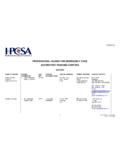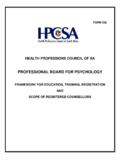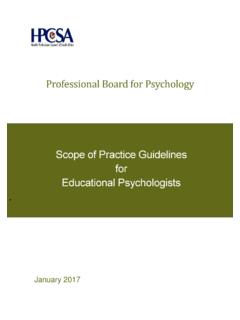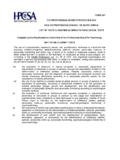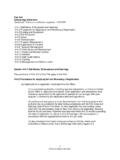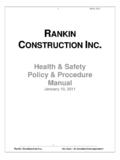Transcription of HEALTH PROFESSIONS COUNCIL OF SOUTH AFRICA
1 1 19 FEBR 2010 FORM 322 HEALTH PROFESSIONS COUNCIL OF SOUTH AFRICA PROFESSIONAL BOARD FOR DENTAL THERAPY AND ORAL HYGIENE PREPARATION GUIDE FOR THE BOARD EXAMINATION FOR DENTAL ASSISTANTS 2 19 FEBR 2010 1 LEARNING CLUSTER: OVERVIEW OF DEFINITIONS DENTITION AND CHARTING Name and identify the location of each tooth surface Distinguish between primary, mixed, and permanent dentitions Describe the FDI charting system 2 LEARNING CLUSTER: INFECTION CONTROL Microbiology Discuss pathogenes of importance in the dental practice, hepatitis, TB, herpes, HIV/Aids Types of pathogenes that are relevant to dentists or in the dental practice Disease Transmission and Infection Control Describe the chain of infection and preventing transmission of infectious agents/disease in oral HEALTH care facilities List standard precautions for diseases transition What is the rational standard for precautions Identify the categories of risk for occupational exposure.
2 Occupational HEALTH and safety Describe the pre-and post exposure protocols for an exposure incident Explain proper hand hygiene for oral HEALTH care workers Explain the advantages of alcohol-based hand rubs Discuss the types of PPE needed for Dental Assistants Explain the importance of various types of personal protective equipment Demonstrate the proper sequence for donning and removing personal protective equipment Identify the various types of gloves used in an oral HEALTH care facility Describe the proper handling and disposal methods for each type of waste generated in dentistry Explain the precautions necessary when treating an active tuberculosis patient Identify Spaulding s classification of instruments surface as it relates to sterilization and disinfection Principles and Techniques of Disinfection Explain why dental treatment-room surfaces need barriers or disinfection List the types of surfaces in the oral HEALTH care facility typically covered with barriers Describe the two methods to deal with surface contamination Explain the difference between disinfection and sterilization Explain the difference between a disinfectant and an antiseptic Identify chemical products used for intermediate-level and low-level surface disinfection.
3 And explain the advantages and disadvantages of each 3 19 FEBR 2010 Demonstrate the process of cleaning and disinfecting all surfaces in a treatment room Describe the processes of pre-cleaning contaminated dental instruments Explain the precautions when using chemical sterilants/disinfectants Principles and Techniques of Instrument Processing and Sterilization Discuss the steps in processing dental instruments Describe the three most common methods of heat sterilization and the advantages and disadvantages of each Describe the precautions necessary when packaging materials for sterilization Describe the steps in cleaning and sterilization of the high-speed dental hand piece Describe the safety precautions necessary when operating an ultrasonic cleaner Know the different types of sterilizers Chemical and Waste Management Identify types of regulated waste generated in an oral HEALTH care facility Identify types of toxic waste generated in an oral HEALTH care facility Describe how to package regulated waste for transport 3 LEARNING CLUSTER.
4 DIAGNOSIS AND TREATMENT PLANNING The Patient Record Identify the purpose of a patient s record Discuss the importance of the patient s medical/dental HEALTH history and its relevance to dental treatment and medication Oral Diagnosis and Treatment Planning Discuss the role of the Dental Assistant in the clinical examination Differentiate between an anatomic and a geometric diagram (box chart) for charting Discuss the importance of a treatment plan The Medically and Physically Compromised Patient Discuss the diseases and conditions of importance in the medical history related to dentistry Discuss the importance of the patient s medication and its relevance to dental treatment Cardiovascular myocardial infarction, angina, hypertension, congestive heart failure, rheumatic fever, infective endocarditis ( pace maker ) Lung conditions asthma, TB Neurological conditions epilepsy, mental retardation, stroke, cerebral palsy, sensory impaired (blind and deaf)
5 Diabetes Pregnancy Infectious diseases hepatitis, HIV/Aids Young and geriatric patients 4 19 FEBR 2010 Principles of Pharmacology Describe the common signs and symptoms of an emergency and how to recognize them List the basic items that must be included in an emergency kit Discuss the use of a defibrillator in an emergency Describe how to respond to specific emergencies 4 LEARNING CLUSTER: RESTORATIVE DENTAL PROCEDURES Restoration and Aesthetic Dental Materials List the properties of dental materials and how they affect their application Describe the properties of all restorative materials (amalgam, composite resin, glass ionomers and temporary materials) and its application in restoring teeth Dental Liners, Bases, and Bonding Systems Discuss how the sensitivity of a tooth determines what type of dental material is selected for a procedure Discuss how and why cavity liners, varnishes, dentin sealers, dental bases are used in restoring tooth structure Describe the etching and bonding process of a tooth and related materials Dental Cements Describe luting cements and differentiate between permanent and temporary cements General Dentistry Discuss the differences in assisting with an amalgam versus a composite restoration Describe the need for placement of an intermediate restoration (temporary)
6 Describe the procedure of composite veneers Matrix Systems for Restorative Dentistry Describe the type of matrices used for anterior and posterior restorations Discuss the purpose and use of a wedge Discuss alternative methods of matrix systems used in restorative dentistry 5. ETHICS AND HUMAN RIGHTS Ethical Consideration A. Define the ethical behavior B. Define five ethical concepts that are important to a dental assistant 5 19 FEBR 2010 i. Confidentiality ii. Respect for the profession iii. Respect for fellow staff and dentist iv. Maintain skills and knowledge v. Refrain from services prohibited by state law Risk Management Consideration A. Define risk management B. List seven elements of an informed consent i. Description of treatment ii. Alternative of treatment iii. Risk of complications iv. Prognosis v. Cost vi.
7 Time needed to complete vii. Age and mental capacity of patient C. Explain three ways to obtain informed consent i. Implied consent ii. Verbal consent iii. Written consent D. Describe thirteen ways to manage risk i. Informed consent ii. Review medical history iii. Emergency preparedness iv. Clear/realistic patient expectations v. Maintain high level of skills vi. Adequate patient safety equipment vii. Disclosure of unexpected events viii. Comprehensive/accurate treatment record ix. Never criticize previous treatment x. Protect privacy of patient (HIPP) xi. Document privacy of patient (HIPPA) xii. Identify responsibility/obligations in the dentist/patient relationship xiii. How to respond to a threat of malpractice suit E. List Six Guidelines for Managing Chart Entries as a Legal Record i. Keep a separate chart for each patient ii.
8 Correct errors properly iii. Make chart entry during patient visit, do not rely on memory iv. Write legibly, ink date and initial each entry v. The entry should be complete vi. Never change or alter the chart after a problem arises 6 19 FEBR 2010 6 LEARNING CLUSTER: PROSTHODONTICS Impression Materials List the three types of impressions taken in an oral HEALTH care facility Describe the types of impression trays and their characteristics of use Discuss hydrocolloid impression materials and their uses, mixing techniques, and application Discuss elastomeric impression materials and their uses, mixing techniques, and application Describe the importance of an occlusal registration and its use in a procedure Discuss the safety precautions that should be taken in the dental laboratory List the types of equipment found in a dental laboratory and their uses 7 LEARNING CLUSTER.
9 ENDODONTICS Explain emergency endodontics Explain emergency routine Explain stages in endodontics procedures Explain material in endodontics Explain instruments in endodontics 8 LEARNING CLUSTER: PERIODONTICS Distinguish between periodontitis and gingivitis Explain plaque and calculus Explain the causes of periodontitis and gingivitis Identify and describe the instruments used in periodontal therapy Discuss periodontal surgical dressing materials and techniques applied Identify the risk factors that contribute to periodontal disease and dental caries Describe dental therapies for periodontal diseases 9 LEARNING CLUSTER: ORAL AND MAXILLOFACIAL SURGERY 9A. Preparation of surgery Describe the indications for oral and maxillofacial surgery Discuss the role of the Dental Assistant during oral surgery Discuss the importance of the chain of asepsis during a surgical procedure Identify instruments used for surgical procedures including extractions Describe post-operative care, including possible complication, given to a patient after a surgical procedure Explain different types of four asepsis 7 19 FEBR 2010 9B.
10 Anaesthesia and Pain Control Reasons to use nitrous oxide Explain the equipment Prepare and check the equipment prior to the procedure Explain the side effects of nitrous oxide 9C. Local Anaesthetics Different types of anaesthetics Different types of topical anaesthetics Different types of local anaesthetics Explain side effects of local anaesthetics 10 LEARNING CLUSTER: ORTHODONTICS Orthodontics Identify and give the functions of the basic orthodontic instruments and materials used Pre and post instructions. 11 RADIOGRAPHY Foundations of Radiography, Radiographic Equipment, and Radiation Safety Discuss the effects of radiation exposure on the human body Describe the methods of protecting the public, patient and oral HEALTH care workers from excess radiation Dental Film and Processing Radiographs Describe the care and maintenance of the processing solutions, equipment, and equipment accessories used in manual and automatic film processing Describe common film processing (time and temperature)
